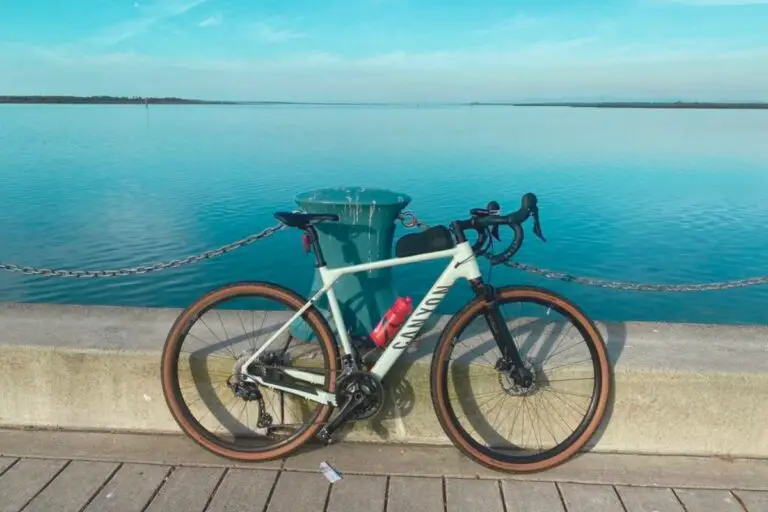Gravel biking is not just a sport; it’s a revelation.
It demands grit, teaches resilience, and offers unmatched scenery. Unlike regular biking, it throws unpredictable challenges at you.
Embracing this sport transforms your view of biking and nature.
This guide simplifies your start into a rewarding adventure.
Choosing the Right Gravel Bike
Understanding Bike Geometry
When it comes to gravel biking, the right geometry can make all the difference. Your gravel bike should have a relaxed geometry for comfort on long rides.
You may also want a bike with wider tire clearance, as gravel riding typically involves navigating through various terrains, such as tarmac, gravel, and dirt roads. Look for tire clearance around 34mm or more for optimal performance.
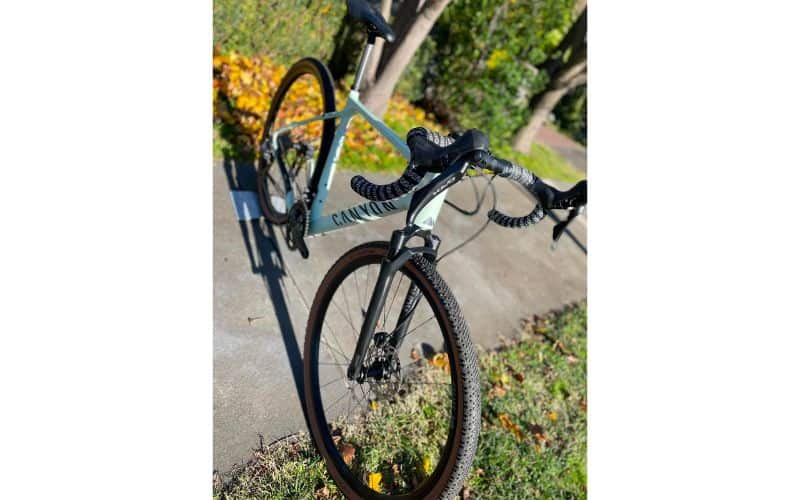
Gravel Bikes vs Road Bikes vs Mountain Bikes
Gravel bikes sit somewhere between road bikes and mountain bikes in terms of design and functionality.
While you can potentially use a road bike for gravel biking by making some modifications, it won’t be as comfortable or suited to off-road conditions. Mountain bikes, on the other hand, are built for off-road riding but may be slower and less efficient on smoother surfaces.
Let’s break it down:
- Gravel Bikes: Versatile, drop handlebar, 700c or 650b wheels, and knobby tires for various terrains.
- Road Bikes: Lightweight, narrow tires and aerodynamic design for efficient speed on paved roads.
- Mountain Bikes: Sturdy, wide tires and suspension for tackling rough off-road trails.
Choosing Based on Budget
When selecting a gravel bike, consider your budget and what features matter most to you.
Gravel bikes come in various frame materials, such as steel, aluminum, titanium, and carbon. Each material has its benefits:
- Steel: Durable and affordable but slightly heavier.
- Aluminum: Lightweight and affordable but less comfortable on rough terrains.
- Titanium: Expensive but offers a great weight, strength, and comfort balance.
- Carbon: Extremely lightweight and comfortable but can break the bank.
Don’t forget to consider components, such as gears and brakes. A good rule of thumb is to aim for a gear ratio of at least 1:1 for tackling steep inclines.
In addition to your bike selection, make sure to account for other costs, such as helmets, shoes, and other essential gear.
To help you get started, here’s our list of the best bikes at various price points:
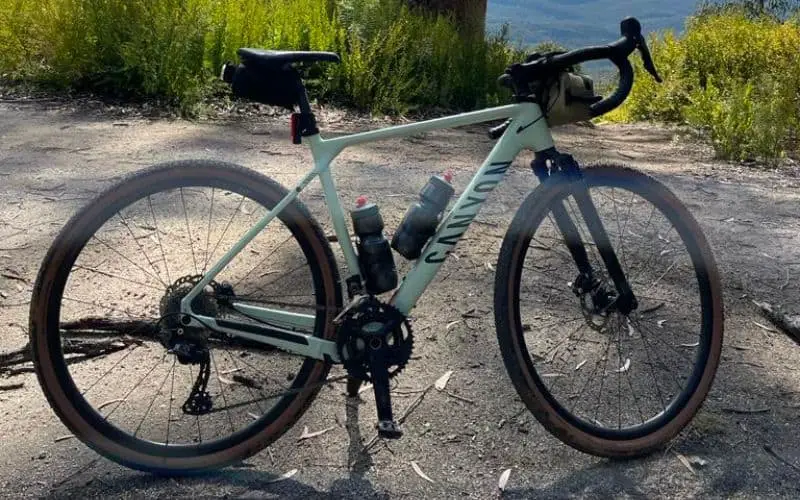
Gravel Biking Equipment and Accessories
Selecting the Right Biking Apparel
When bikepacking or touring, it’s essential to wear the appropriate clothing. Dressing in layers is a great way to regulate your body temperature and adapt to changing weather conditions. Here are some key items to consider:
- Jersey: Look for a breathable, moisture-wicking material that will keep you dry and comfortable.
- Bib Shorts or Shorts: Choose padded shorts for added comfort on long rides, ensuring they fit properly.
- Gloves: Select gloves that offer cushioning, grip, and protection from debris.
- Cycling Socks: Opt for durable, moisture-wicking socks with ample arch support.
- Cycling Shoes: Pick shoes with stiff soles and appropriate cleats for your gravel bike pedals.
Options for Roadside or Trailside Repairs
Being prepared for potential bike malfunctions on the trail is crucial. Here are some essential tools and items you should pack in your saddlebag or hydration pack:
- Multi-tool: A versatile, compact tool with various functions, including hex wrenches, screwdrivers, and chain tools.
- Tire levers: These handy tools assist in removing and installing bike tires.
- CO2 inflator or mini pump: These compact devices are a must-have for quick tire inflation.
- Patch kit: This small kit allows you to fix a punctured tire temporarily.
- Spare tube: Bring an extra tube for your specific bike tire size.
Important Safety Gear
Safety should always be a top priority while gravel biking. Here is a list of essential safety gear for your ride:
- Helmet: Invest in a high-quality, well-ventilated helmet specifically designed for off-road cycling.
- Lights: Equip your bike with powerful front and rear lights for increased visibility.
- Hydration pack: Stay hydrated during your ride with a convenient hydration backpack or water bottles.
- Eyewear: Protect your eyes from dust, debris, and glare with suitable cycling glasses.
- First-aid Kit: Carry a small, lightweight first-aid kit for minor injuries and emergencies.
Mastering the Technique and Control
Gravel biking is a challenging but rewarding adventure that requires different skills than regular road cycling.
Effective Braking and Descending
Proper braking and descending techniques are crucial for all cyclists, especially when navigating gravel. Remember these key points:
- Feather your brakes: Gently apply both brakes, gradually adjusting the pressure instead of abruptly slamming them. This helps you control your speed and prevents skidding on loose surfaces.
- Shift your body weight: When descending, lean your body back to maintain stability and distribute weight more evenly over the rear wheel, providing better traction.
- Stay loose: Keep a relaxed grip on the handlebars and let your bike move beneath you as you navigate uneven terrain. This allows you to respond quickly if your wheels slip or if you encounter unexpected obstacles.

Skills for Riding on Gravel and Unpaved Roads
Here are some tips to help you master riding on different surfaces:
- Standing: Try standing on the pedals when the terrain gets rough to absorb the bumps, providing a smoother, more comfortable ride.
- Keep a light grip: Holding the handlebars too tightly can lead to arm fatigue and decrease your ability to react. Maintain a light, comfortable grip to improve control.
- Picking a line: Be attentive to the trail ahead and strategically choose the smoothest, safest line to follow – this will make your ride more pleasant and safer.
Improving Traction and Stability
There’s nothing worse than feeling unstable and unconfident on a gravel bike. Improve your traction and stability with these techniques:
- Tire selection and pressure: Choose wider tires with good grip, and adjust the pressure according to the trail conditions. Lower pressure typically provides better traction on gravel and uneven surfaces.
- Pedal position: Instead of continuously spinning, keep one foot at the 3 o’clock position and the other at 9 o’clock, creating a stable platform and allowing for quick power bursts when needed.
- Cornering: When cornering, lean your bike into the turn while keeping your body weight centered over the tires. This will help maintain grip and prevent slipping.
Understanding Bike Components and Performance
When starting out in gravel biking, it’s crucial to understand the different bike components and their performance to help you make informed choices and ride comfortably.
Selecting the Right Wheels and Tires
Choosing the appropriate wheels and tires is a critical aspect of gravel biking. Gravel bikes can accommodate 650b and 700c wheels.
- 650b wheels are smaller, accommodate wider tires, and are often chosen for comfort and versatility in mixed terrain and off-road conditions
- 700c wheels are larger and more suited for speed and efficiency on smooth roads
Tire width also plays a significant role in your biking experience. Wider tires offer more surface area for better grip and control, while narrower tires provide less friction and a faster riding experience. Typically, gravel bike tires range from 30mm to 56mm (2.2 inches) in width.
For optimal performance, it’s essential to pay attention to tire pressure. Lower pressures allow for better traction and shock absorption, while higher pressures increase rolling efficiency. Additionally, tubeless tires have become popular in gravel biking because they eliminate the risk of pinch flats and provide improved comfort and puncture resistance.
Finally, when it comes to tread patterns, knobby tires are perfect for tackling loose gravel and off-road terrains, as they provide excellent grip and control.
Understanding Gears, Drivetrains, and Brakes
The gearing system on your gravel bike plays a pivotal role in determining how smoothly you ride through different terrains. Your bike’s gearing involves the chainrings, cassette, derailleurs, and shifters. Ideally, you’ll want a wider range of gears for tackling steep climbs and fast descents.
With drivetrains, you can choose between single and double-chainring setups.
- Single chainrings offer simplicity, ease of maintenance, and reduced weight
- Double chainrings provide a wider gear range for varying terrain.
Choosing the setup that best meets your riding style and the areas you intend to ride is important.
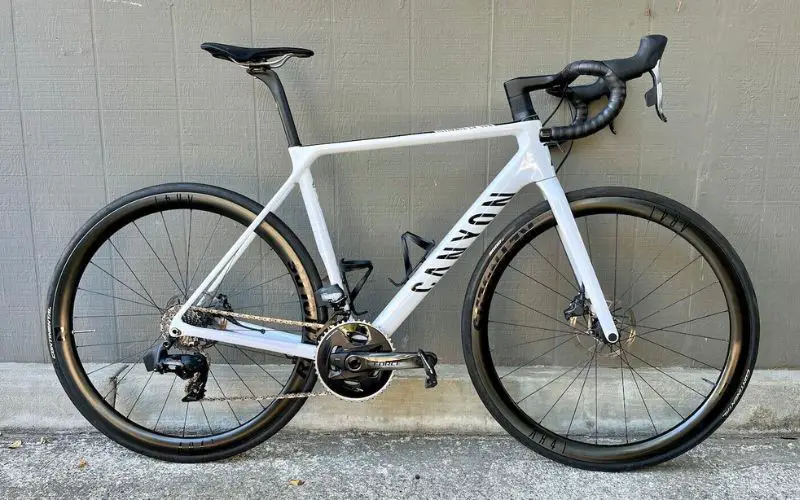
Lastly, your gravel bike’s braking system is vital for safety and control. Disc brakes have become the gold standard in gravel biking, offering superior stopping power, even in wet or muddy conditions. Additionally, disc brakes provide better modulation and require less maintenance than their rim brake counterparts.
Maintaining Comfort During the Gravel Ride
Riding on gravel can sometimes feel bumpy, but don’t worry! You’ll have a much more comfortable and enjoyable experience with a few simple adjustments.
Choosing the Right Pedals and Shoes
Having the right pedals and shoes makes a world of difference when it comes to stability and efficiency on your gravel ride.
First things first, consider switching to clipless pedals, which provide a more secure connection between your feet and your bike. This ensures that you can pedal more efficiently and improves your endurance.
Now, let’s talk about cycling shoes. When cycling on gravel, pick shoes that have enough stiffness for efficient pedaling but also provide flexibility for walking. Remember that you may need to dismount and walk in certain sections. Also, make sure that your shoes are comfortable for long periods and support your arches.
Seat and Handlebar Adjustments
Adjusting your bike’s saddle and handlebars is crucial for your comfort during the gravel ride.
First, let’s focus on the saddle. A well-fitted saddle can determine your overall comfort on your bike. Start by checking your saddle’s height, making sure your leg reaches a slight bend when the pedal is at the lowest point. Don’t forget about saddle tilt – a level or slightly tilted saddle is typically more comfortable.
Next up, handlebar adjustments. The right height and reach of your handlebars can significantly improve your control and stability on your bike. Generally speaking, gravel bikes have a more relaxed geometry with higher handlebars than regular road bikes. Adjust the handlebars so there’s a slight bend in your elbows when riding. This will help you maintain control while staying comfortable.
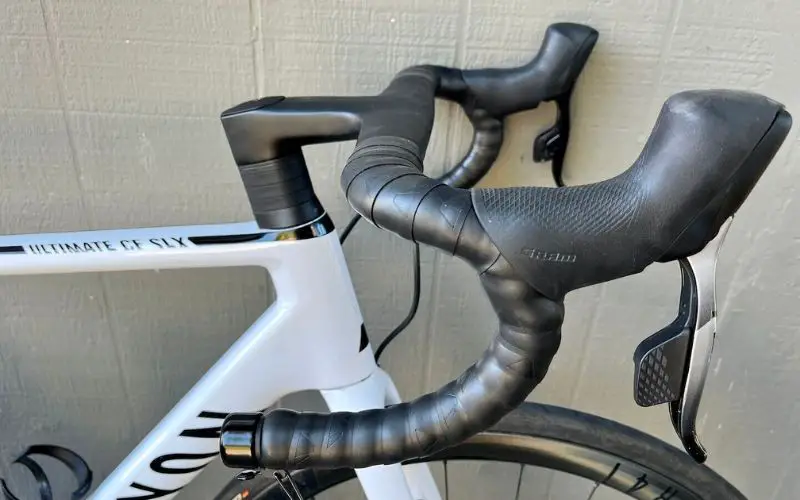
One more tip to consider: investing in a pair of cycling shorts with good padding can be a game-changer for your comfort. Trust us. Your lower body will thank you during those long hours on the saddle!
Preparation and Planning for Gravel Biking
Finding the Right Trails
When you’re starting out with gravel biking, the first step is to find the perfect trail for your adventure.
Luckily, countless gravel and unpaved roads are just waiting to be explored. You can use a good map (like Komoot or RideWithGPS), a GPS device, or even a dedicated route planner to plan your route. Many gravel bikers also use smartphone apps or websites to find popular routes with varying difficulty levels.
Don’t be afraid to ask fellow cyclists for recommendations – there’s no shortage of advice and shared experiences in the gravel biking community.
Understanding Weather and Terrain
Before heading out on a gravel ride, paying attention to the weather forecast and terrain conditions is essential.
This knowledge will help you plan your route accordingly and prepare for any unexpected hazards you may encounter. Be mindful of how rain affects the trail, and ensure you have the appropriate equipment to tackle muddy or slippery stretches along the way.
Adapting your tire pressure is another trick to ride smoothly, even on ever-changing terrain.
Planning for Nutrition and Hydration
Proper nutrition and hydration are vital when embarking on a gravel biking adventure. Plan your meals and snack breaks according to your route distance to ensure you have the energy to complete your ride.
- For shorter trips, a single water bottle and energy bar will suffice.
- For longer rides, consider carrying a hydration backpack and a mix of energy-dense snacks, such as nuts or trail mix.
Staying hydrated and consuming the right nutrition before and during your ride is essential. This will help you maintain energy levels and avoid fatigue or discomfort on the trail.
Exploring the World of Gravel Biking
Gravel biking is a fantastic way to experience two-wheel adventure and freedom.
By navigating through diverse terrains such as gravel roads, dirt tracks, and pavement, you’ll relish the challenge and excitement of new experiences. We’ll examine how you can participate in gravel bike races and plan a bikepacking adventure.
Participating in Gravel Bike Races
Are you ready to push yourself to the limit? Gravel racing is an exhilarating experience where you can compete against other cyclists while traversing tough terrains.
Follow these tips when preparing for your first race:
- Choose the right race for you: A wide variety of gravel races are available, so pick one that suits your experience level and desired challenge.
- Train adequately: Develop a training plan that covers endurance, strength, and technical skills to ensure you’re well-prepared for race day.
- Know the course: Familiarize yourself with the route so you know what to expect and can plan your strategy accordingly.
- Opt for the right gear: Invest in a versatile gravel bike and wear appropriate clothing and safety gear for the race conditions.
- Maintain your bike: Regularly inspect and maintain your bike to minimize the chance of mechanical issues on race day.
Planning a Bikepacking Adventure
If the call of the wild has piqued your interest, bikepacking is an unforgettable way to explore the outdoors. Combining cycling, camping, and self-sufficiency, you’re bound to create memories that will last a lifetime.
To make the most of your bikepacking journey, check out these tips:
- Select your destination: Choose a route that satisfies your thirst for adventure, whether it’s through remote wilderness or along scenic country roads.
- Plan your route: Map your daily distance, stops, and potential campsites. Remember to factor in terrain difficulty and weather conditions. Putting together a solid plan will make your trip go smoothly.
- Gather the essentials: Pack a lightweight tent, sleeping bag, compact stove, food, water, navigation tools, and necessary repair kits. Keep weight distribution in mind as you pack your bike bags.
- Take safety precautions: Inform someone of your route, carry a first aid kit, and be prepared for unexpected situations (e.g., adverse weather, getting lost, or encountering wildlife).
- Adapt and enjoy: Embrace the unexpected and enjoy the journey, even if things don’t go exactly as planned.
Frequently Asked Questions
How Do I Choose the Right Gravel Routes?
Start with beginner-friendly routes that are flat and not too remote. Utilize GPS apps and local cycling clubs to find recommended gravel paths. Pay attention to weather conditions, which can significantly affect gravel road conditions.
What Fitness Level is Required for Gravel Biking?
Gravel biking is accessible to most fitness levels. Start with shorter, easier routes and gradually increase distance and difficulty as your fitness improves.
Can I Use a Road or Mountain Bike for Gravel Biking?
While possible, these bikes may not offer the same comfort and performance on gravel as a dedicated gravel bike. Road bikes have narrower tires and are less stable on loose surfaces, while mountain bikes may be heavier and less efficient on longer, flatter routes.
Can Gravel Biking Improve My Overall Cycling Skills?
Absolutely! Gravel biking improves balance, bike handling, and endurance. It also enhances your ability to ride comfortably on various terrains, making you a more versatile cyclist.

